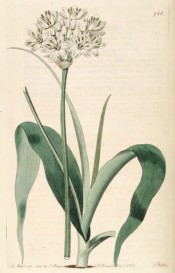Allium neapolitanum Cirillo var. cowanii
Half-hardy perennial with somewhat flaccid, stem-sheathing, lance-shaped leaves which often wither before flowering time, and white flowers with spreading petals in multi-flowered umbels. [RHSE].
Horticultural & Botanical History
First botanically described by Cirillo in 1788 [Plantarum Rariorum regni Neapolitani fasc. 1, 1788]. Incorrectly believed to be a true South American species by John Lindley when ‘Roots of this new species of allium [Allium cowanii] were sent to the Horticultural Society from Peru in 1823, by James Cowan.’ [BR f.758/1823].
‘Although several species of the same genus had been discovered in North America, some of which are said to be identical with those of Europe or Asia, none had been known to be natives of the southern part of the new world before the arrival of the kind we are now describing. It is nearly related to the common Allium ursinum of this country, from which it is distinguished by its leaves being ciliate, a little undulated, and much more flaccid, with quite a different outline; its petals are obtuse, not pointed.’ [BR f.758/1823]. Allium neapolitanum is figured in the Ornamental Flower Garden [OFG f.283/1854].
History at Camden Park
Listed in all published catalogues [B.32/1843].
Notes
Published Jan 16, 2009 - 04:38 PM | Last updated Mar 03, 2012 - 04:14 PM
| Family | Alliaceae |
|---|---|
| Category | |
| Region of origin | Originally from North Africa and Southern Europe. Although present in South America it was probably introduced. |
| Synonyms |
|
| Common Name | Naples onion |
| Name in the Camden Park Record | Allium Cowani
|
| Confidence level | high |
